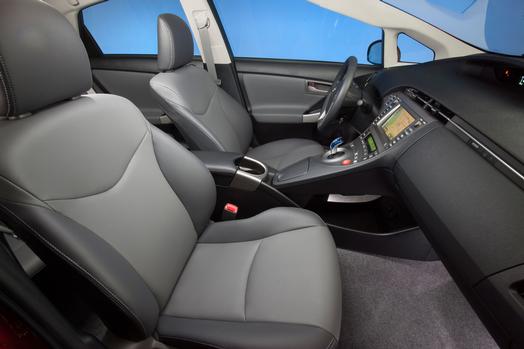The Toyota Prius, the brand’s first production gas-electric hybrid model, remains the world’s best-selling hybrid with more than three million sold worldwide since its introduction. The Prius also continues to dominate the hybrid category in the United States, where more than 1.5 million Prius vehicles have been sold since 2000.
Beyond its tremendous sales success, the Prius also focused attention on the potential for hybrid vehicles to help reduce cars’ environmental impact. The third-generation Prius model became the foundation of a family of hybrid models, offering a Prius for every lifestyle, the family includes the larger Prius v, the city-friendly Priusc and the Prius Plug-in Hybrid. In addition, Toyota also offers hybrid versions of its Camry and Avalon sedans and the Highlander crossover SUV. Prius is a hybrid vehicle market leader that accounts for over 40% of total hybrid vehicle sales volume. In terms of number of models offered and sales volume, Toyota is the world leader in hybrid vehicles.

50 MPG Combined Fuel Economy Estimates in a Midsize Package
Because of its interior roominess, Prius is classified as a midsize car by the EPA, thus making it the most fuel-efficient car without a plug in that segment. With ratings of 51 MPG city / 48 MPG highway / 50 MPG combined. Reflecting the advanced state of Toyota hybrid technology, the combined figure is nearly 25-percent higher estimate than for the smaller first-generation Prius.
Toyota offers the 2014 Prius in four model grades, known as Prius Two, Three, Four and Five. The Three and Four models offer as an option the world’s first sliding glass moonroof packaged with solar panels, located over the rear seating area. These power a ventilation system that helps reduce the interior air temperature when the car is parked in the sun. The available remote air conditioning system allows remote operation, enabling the driver to lower the interior temperature for comfort before getting into the car.
Prius PLUS Performance accessory package
Hybrid drivers like to have fun, too, and so Toyota offers the dealer-installed PLUS Performance accessory package to give the Prius a sporty look and sharper handling. Engineered by Toyota Racing Development (TRD), the package starts with a seven-piece aerodynamic ground effects kit for a lower-profile stance. It’s functional, too, as the custom body kit was designed to reduce the vehicle’s coefficient of drag and therefore help maintain high fuel efficiency.
The package equips the Prius with 17-inch forged alloy wheels with a custom offset to increase track width while also maintaining low rolling resistance. The lighter wheels, which have low-profile 215/45R17 tires, reduce unsprung weight to aid agility. The TRD track-tuned springs lower the vehicle 1.1 inches in the front and 1.3 inches in the rear to enhance steering response and cornering performance, and a rear stabilizer bar helps reduce body lean for flatter cornering.
Hybrid Synergy Drive
Introduced with the second-generation Prius 10 years ago and significantly enhanced with lighter, more efficient components for the third-generation model, Toyota’s Hybrid Synergy Drive combines the output of a 1.8-liter Atkinson-cycle, four-cylinder engine with and electric motor. The combined 134 net system horsepower feels even stronger to the driver due to the unique way the system combines the power of the gasoline engine and electric motor.
A full hybrid, the Prius can run on the gasoline engine alone, battery alone, or a combination of both. The driver can select from among four driving modes, “Normal,” “POWER,” ECO” and “EV.” The EV Mode allows driving on battery power alone at low speeds for about a mile, if conditions permit. POWER Mode increases sensitivity to throttle input for a sportier feel; ECO Mode helps drivers enhance fuel economy by adjusting throttle input and climate control. A standard Multi-information Display panel monitors the vehicle’s fuel and battery energy, and includes a display that helps the driver adopt economical driving habits.
Prius uses an electric water pump and electric power steering and uses no accessory drive belts. As a result, efficiency is enhanced and maintenance costs are potentially reduced. Regenerative braking helps to recapture electrical energy under deceleration, which helps to reduce fuel consumption.
The 2014 Prius is certified as a Super Ultra Low Emission Vehicle (SULEV) and an Advanced Technology Partial Zero Emissions Vehicle (AT-PZEV) in California and in states applying California emission standards. The AT-PZEV certification requires the SULEV exhaust standard linked with the ability to meet a zero-fuel-evaporative standard, a 150,000-mile durability demonstration, extended emissions system warranty, and technology deemed by the California Air Resources Board (CARB) to advance future fuel cell vehicles. In the rest of the country, Prius is certified as Tier 2, Bin 3.
Futuristic Design, Outside and Inside
A 106.3-inch wheelbase helps to give the Prius a smooth ride and the interior room of a midsize sedan. The third-generation Prius’ 0.25 coefficient of drag (Cd) is one of the lowest for any production car, contributing to its outstanding fuel economy. LEDs (light emitting diodes), optional in low beam headlamps and standard in DRLs and tail lamp clusters, help reduce the vehicle’s power consumption. An exhaust heat recirculation system reduces heat waste by warming engine coolant during cold startup, enhancing performance and delivering heat to the cabin more efficiently.
Vehicle weight is kept low through use of aluminum for the hood, rear hatch, front stabilizer bar and brake calipers and by using super high-tensile strength steel in the inner rocker panel, center pillar and roof reinforcement.
While also conveying a futuristic look and feel, the cockpit offers outstanding roominess and comfort. Controls are easy to reach and easy to use. The Touch Tracer Display features touch sensors on the steering wheel switches that are designed to reduce driver eye movement for better concentration on the road. When the driver touches the steering wheel controls, a duplicate image is displayed on the instrument panel, directly in line of sight.
Advanced Multi-Media Systems
Onboard information and connectivity features live up to the promise of the Prius’ advanced design. The Prius Two grade features a standard Display Audio touch-screen system with a 6.1-inch screen. The AM/FM CD player unit offers MP3/WMA playback capability with six speakers, a USB port for iPod® connectivity, auxiliary input jack, Bluetooth® hands-free phone capability and audio streaming. The display also provides vehicle information and allows the driver to customize vehicle settings.
The Prius Three adds navigation and Entune® App Suite, plus an integrated backup camera display, SiriusXM Satellite Radio capability, HD Radio™ with iTunes® Tagging, and advanced voice recognition. The Toyota Entune® App Suite is a collection of popular mobile applications and subscription-free data services. Once a smartphone is paired to the vehicle using Bluetooth wireless technology or a USB cable, Entune® apps are operated using the vehicle’s controls or, for some services, by voice recognition. Entune® offers apps for Bing™, iHeartRadio, MovieTickets.com, OpenTable®, and Pandora®. Entune® data services include a fuel price guide, sports scores, stocks, traffic and weather.
Prius Four and Five include that system plus eight JBL® GreenEdge™ speakers and an eight-channel JBL amplifier. GreenEdge technology reduces electric draw on the vehicle, which can help enhance fuel economy. When the Deluxe Solar Roof Package is ordered for the Prius Four, or the Advanced Technology Package on Prius Five, that system is further upgraded with a Head-Up Display and Premium HDD Navigation System, which uses a seven-inch touch-screen with split-screen capability.
Safety
An IIHS Top Safety Pick, the Prius is equipped with front and rear side curtain airbags, driver and passenger front seat-mounted side airbags and a driver’s knee airbag.
Active headrests are used in both front seats to help reduce the possibility of whiplash injury in certain types of rear collisions. An Anti-lock Brake System (ABS), Electronic Brake-force Distribution (EBD), Brake Assist (BA), Traction Control (TRAC), enhanced Vehicle Stability Control (VSC) and the Smart Stop Technology brake-override system make up Toyota’s standard Star Safety System™. A Dynamic Radar Cruise Control system, using advanced millimeter wave radar, is an available option. Also available, the Safety Connect telematics system includes automatic collision notification, stolen vehicle locator, emergency assistance button (SOS) and roadside assistance (1-year trial subscription included).
The top-of-line Prius Five model’s Advanced Technology Package includes the Premium HDD Navigation System, plus the Head-Up Display, Dynamic Radar Cruise Control, Pre-Collision System, Lane Keep Assist and Safety Connect. The Pre-Collision System is designed to help reduce crash speed and damage in certain frontal collisions only. It retracts the front seatbelts and applies the brakes in certain conditions when it determines that a frontal crash is unavoidable. Lane Keep Assist is designed to help the driver stay within the center of the lane.
 Asian Fortune Your source for all things Asian American
Asian Fortune Your source for all things Asian American





2 comments
Pingback: 2014 TOYOTA MODEL YEAR
Pingback: Types of Amplifiers |